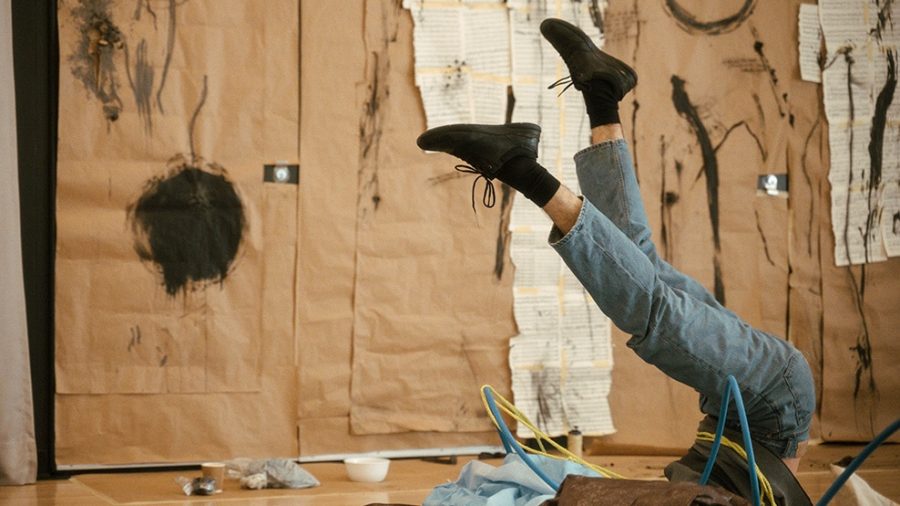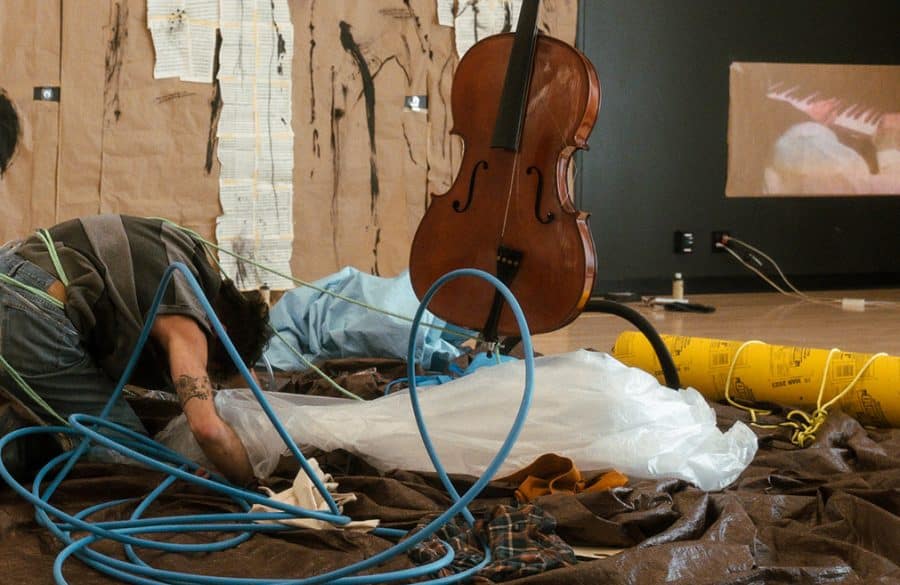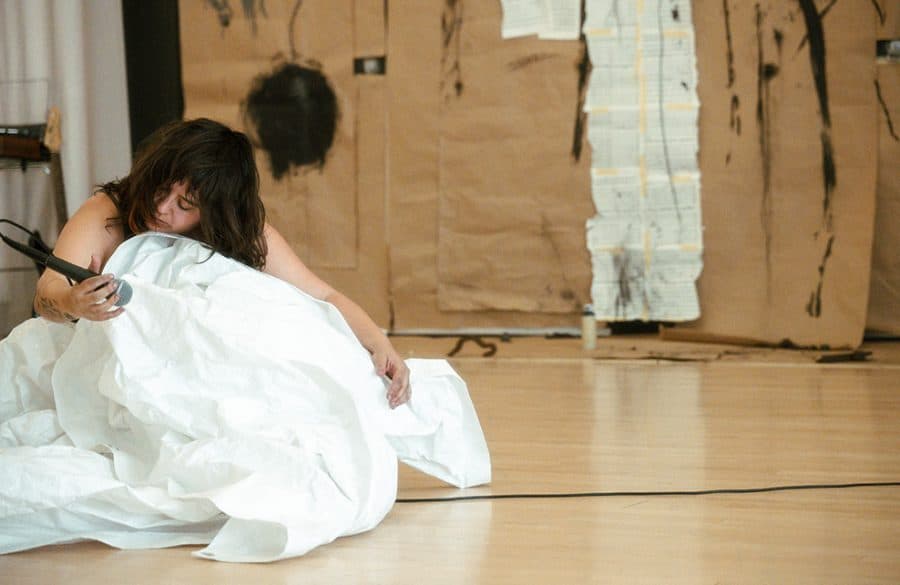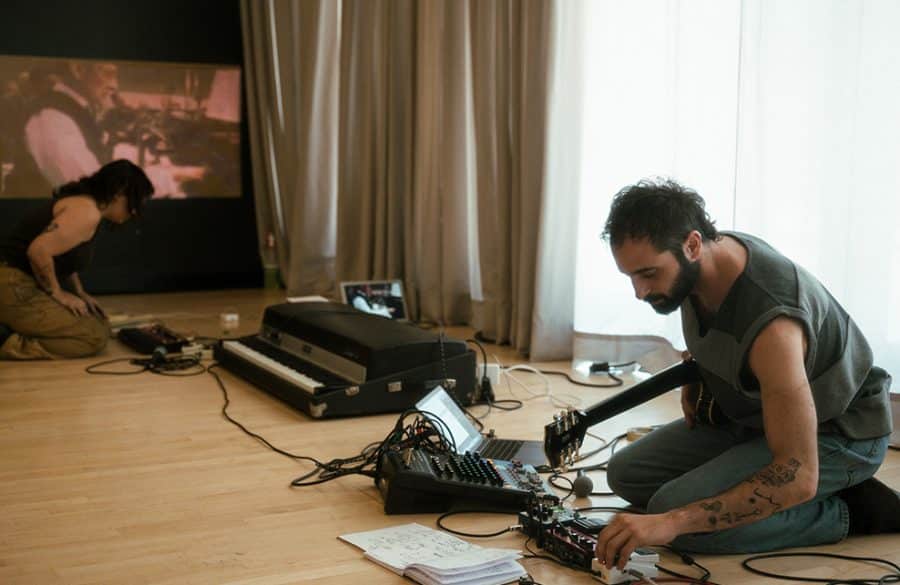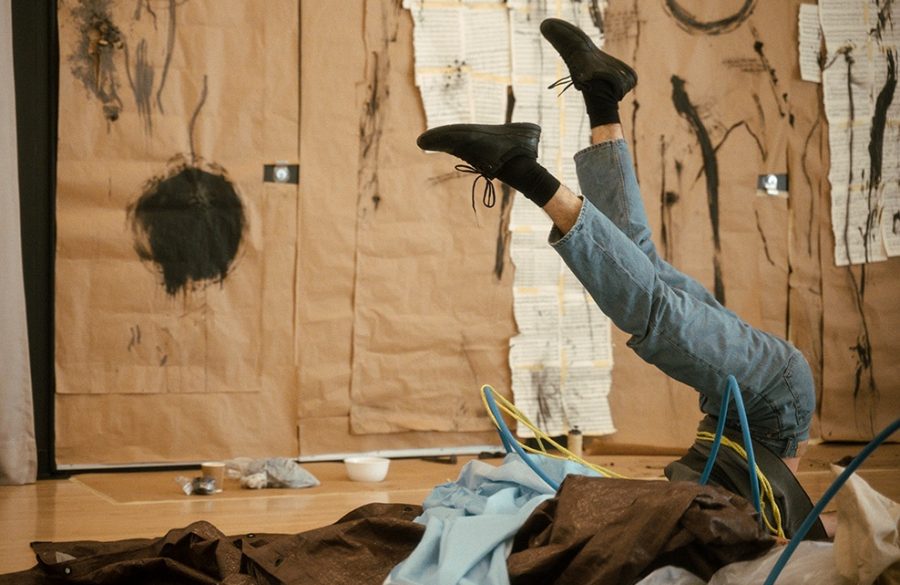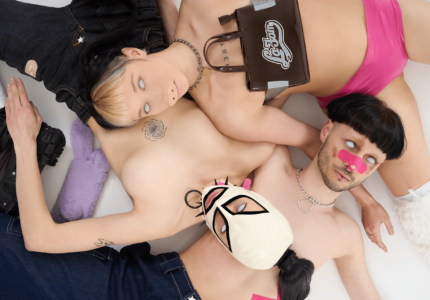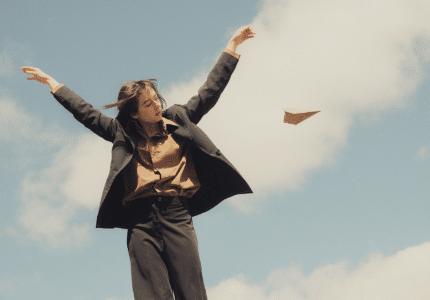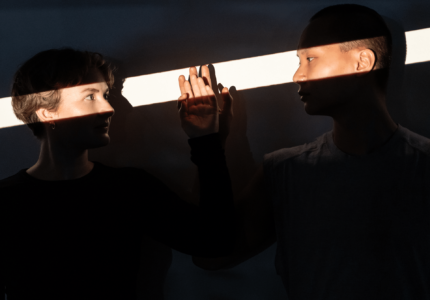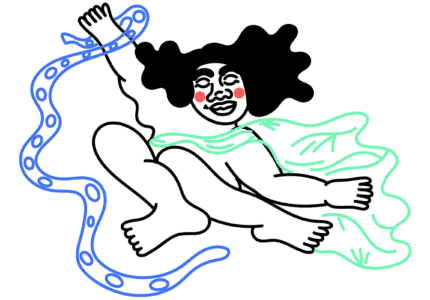Live show
Charlie Prince & Olivia Tapiero
ÉDIFICE WILDER | Espace Orange
September 5, 2024 - 7:30pm
September 6 & 7, 2024 - 7pm
September 8, 2024 - 4pm
Discussion with the artists on September 6
Season launch on Thursday, September 5!
The cocktail starts at 5pm, with French texts by artists Léo “Hit” Coupal, Mara Dupas and Charo Foo Tai Wei about their relationship with dance, with their profession and their community.
- Free drink and snacks
- Presentation of the 2024-2025 season by the curators
- Surprises
Open to all: RSVP
Charlie Prince & Olivia Tapiero
concerto
A body floats through a synthetic landfill beneath a suspended cello. A Mozart piano concerto slows down to the point of disintegration. Incantations are whispered and sung. Traces on a wall generate cavernous sounds of a world succumbing to its own collapse. There is no pianist.
Both a gutted concert and a living installation, concerto stems from an intermittent decade-long collaboration between writer Olivia Tapiero and choreographer Charlie Prince. The two artists become at once technicians, performers, and witnesses. Their gestures unfold in a suspended time, giving way to a profound meditation on the cost of grace, and what it means to mourn the world as the world mourns itself.
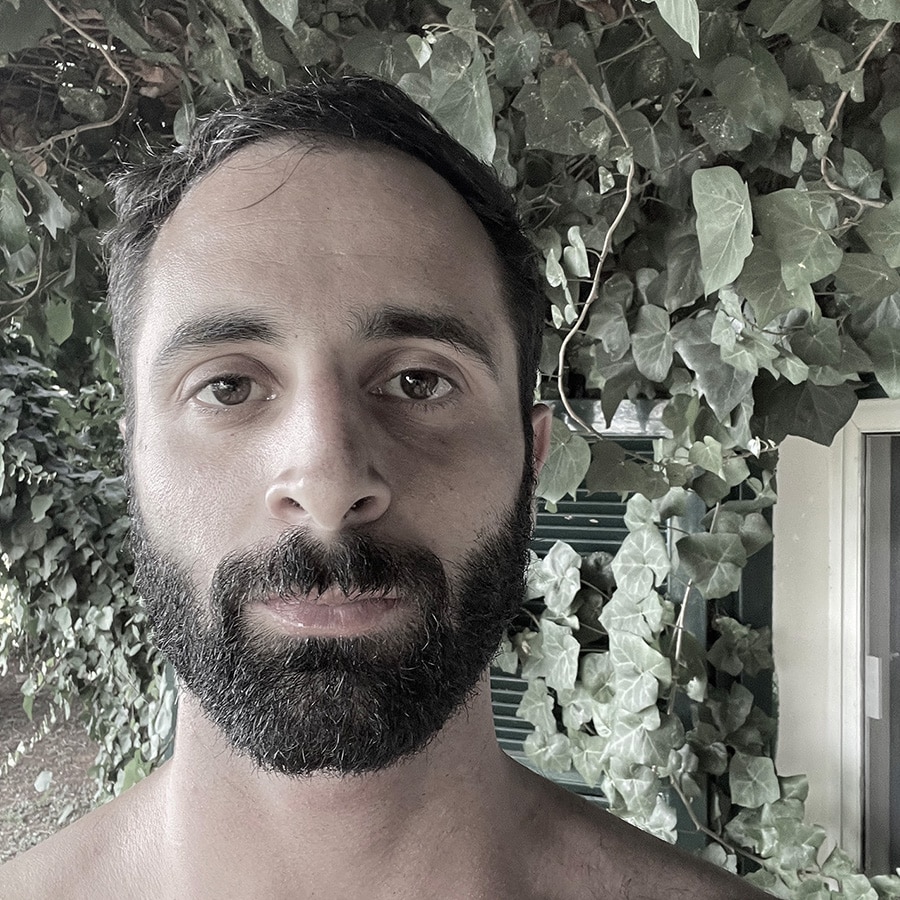
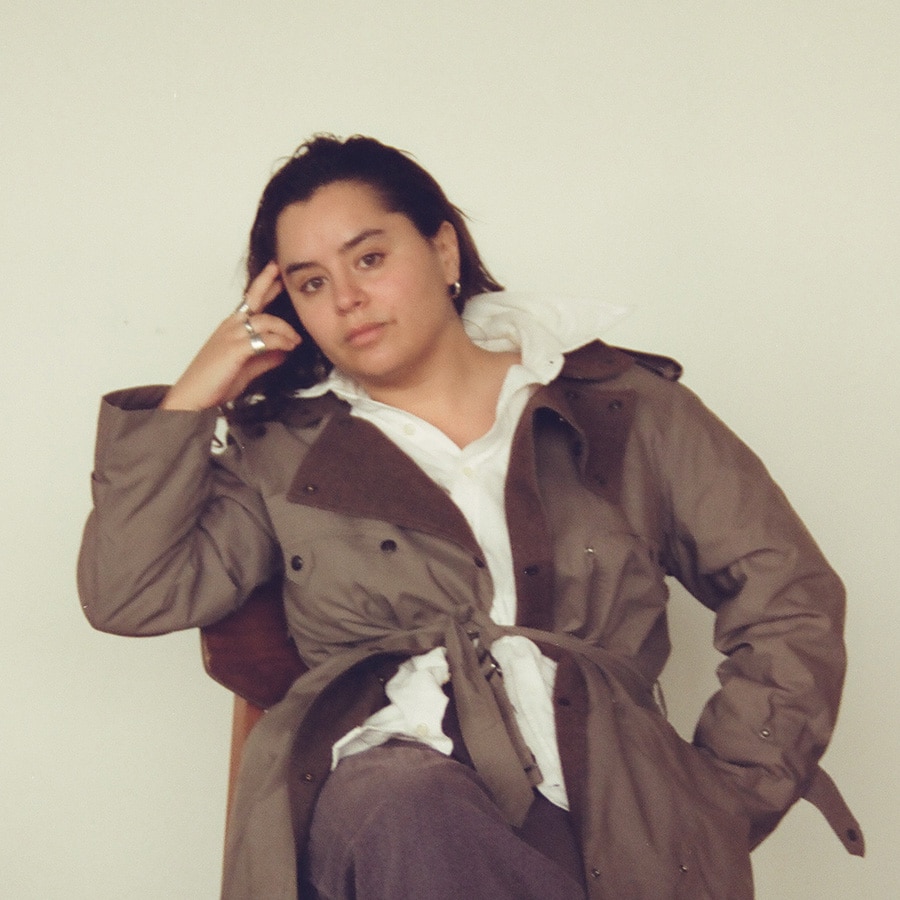
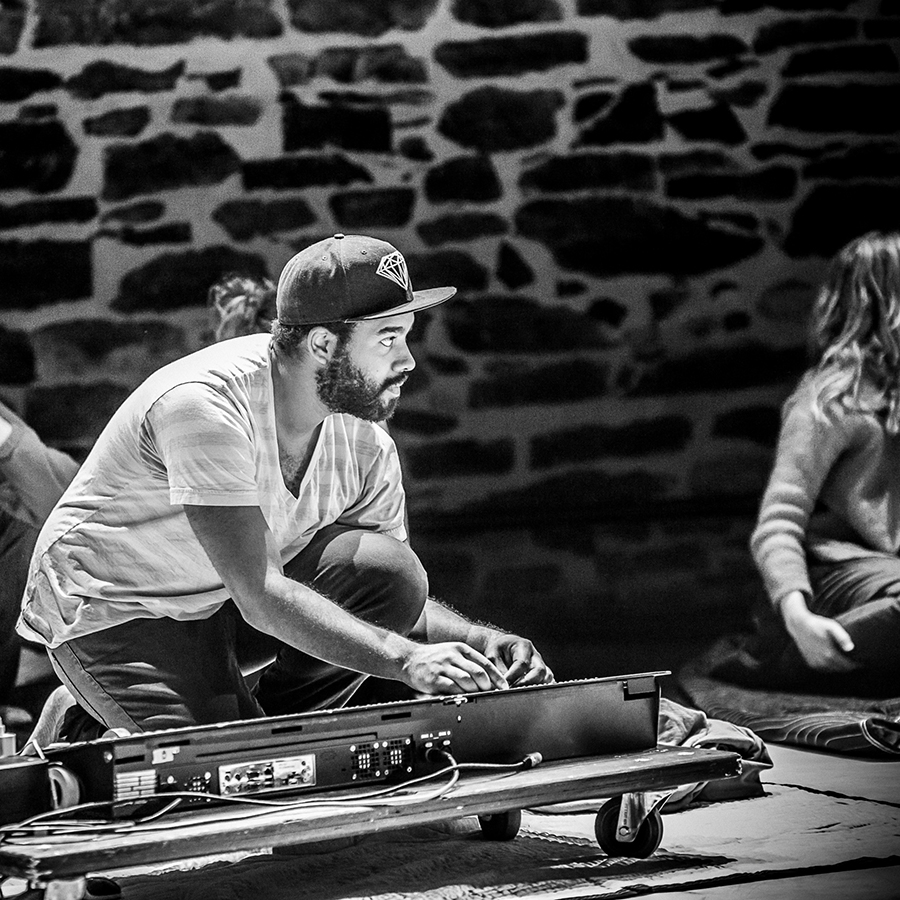
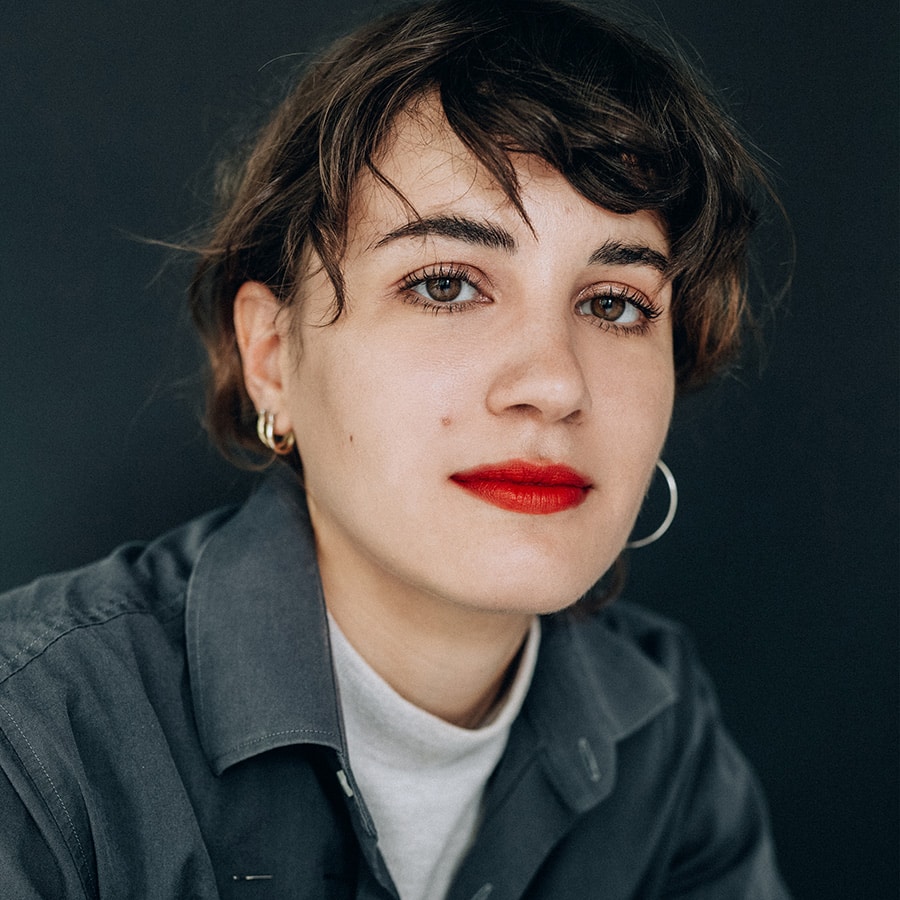
Financial support Canada Council for the Arts, Charleroi Danse (Belgium)
Residencies Parbleux, Caniches Festival, MAI (Montréal, arts interculturels), La Villa Empain – Fondation Boghossian (Belgium), Tangente
Presented in Beirut (2025)
Charlie Prince (1991) is a Lebanese dance and performance artist. His interests are rooted in the intersection of the political and the poetic body, and the many profound resonances this may create. His transdisciplinary choreographic works have been presented in several major festivals and theatres, including ImPulsTanz Festival, Dansmakers Amsterdam, Rencontres chorégraphiques internationales de Seine-Saint-Denis, Vancouver International Dance Festival, Oktoberdans, Fabricca Europa, and Beirut International Platform of Dance. Charlie holds a Bachelor of Music from McGill University in Montréal with a minor in Religious Studies, and continues to engage as a composer in his artistic practice. In 2023 he was artist in residence at the Villa Empain in Brussels, after having received the Prize for Dance and Performance awarded by the Boghossian Foundation in Belgium. He was also an apap (advancing performing arts project) 2020 artist supported by the European Union Commission for Culture from 2017 to 2020.
Olivia Tapiero (1990) is a writer, translator, and musician. Her shifting work is crossed by a sense for disintegration, a contempt towards institutions and nationalism, and the exploration of non-consent to the state of the world. She is the author of Les murs (Robert-Cliche Award, Prix Senghor finalist), Espaces (2012), Chairs (codirection, 2019), Phototaxie (2017) / Phototaxis (2021, Lambda Literary Awards finalist), and Rien du tout (2021, Grand Prix du livre de Montréal Finalist, Governor General’s Literary Awards Finalist). She is editor-in-chief for the literary magazine Moebius, and has also contributed, with her poems and essays, to magazines such as Spirale, Estuaire, Lettres québécoises, tristesse, and MUSCLE. She has also translated works of contemporary writers such as Roxane Gay, Anne Boyer, and Billy-Ray Belcourt. She is slowly seeking to escape the book form in order to integrate an embodied and musical practice to her work. She is based in Montréal.
Paul Chambers graduated from John Abbott College’s Professional Theatre Program, specialization in Design, in 2005. While still enrolled, he begins designing lighting and scenography for many independent English theatre productions in Montréal. From 2005 to 2007, Paul works at the FACE school as a designer, technician and coach, continuing a legacy of creating impressive professional stage designs for youth theatre. His first lighting design credit for dance came with the inauguration of the first edition of Wants&Needs’ popular event Piss in the Pool (2005). From 2008 until 2013, Paul is technical director at Tangente, a contemporary dance presenter in Montréal. During his five-year tenure, he coached 16 emerging technicians and began collaborating as a designer on numerous dance productions. Teaching workshops has also been an important part of his development as an artist and mentor. At Studio 303, he teaches an annual lighting design workshop for emerging artists, a course he has also taught for En Piste and the Quebec Drama Federation. In 2013, he and fellow designer and educator David-Alexandre Chabot inaugurate CHA, a design collective aimed at creating and sharing design-based works with artists across different disciplines. What unifies CHA’s body of work is the way that it communicates with people, each production challenging the audience to place itself at the centre of the proposition to experience it from within. Paul is continually studying and exploring the visual arts, blending his passion for lighting with in-situ and gallery installations.
Sophie El-Assaad is a transdisciplinary artist based in Tiohtià:ke/Montréal who works in the visual and performing arts. Her work spans theatre design and direction, performance, photography, painting, sculpture, video, and installation. Her current practice addresses themes of diasporic identity mediated through sociopolitical frameworks, trauma, and technology. The artist holds an MFA in Visual Arts from the University of Ottawa (2024), and a BFA specialization in Theatre Design from Concordia University (2015). She is the recipient of four Montreal English Theatre Awards and in 2021 was one of three finalists for Montréal’s Jovette-Marchessault prize for her work in design. In 2023, she had the honour of representing Québec in costume design at the Prague Quadrennial of Performance Design and Space.
Marilou Craft (she/they) lives in Tiohtià:ke/Mooniyang/Montréal, where she works as an artist, author, translator, editor, and dramaturgical consultant. She is currently a member of the editorial board of the magazine Estuaire and a dramaturgical advisor associated with the Centre des auteurs dramatiques (CEAD). Her artistic practice is anchored in the margins that she inhabits and that inhabit her: located at the confluence of poetry and the living arts, she probes the gray areas between the intimate and the political to embody their porosity. She performs her creations on stage and on the radio, both solo and in collaboration with poets and musical improvisation artists. Her short forms have been published by La Mèche (Cartographies II: Couronne Nord, 2017) and Triptyque (Corps, 2018; Pauvreté, 2021), as well as in magazines Mœbius and Liberté.
Linda Rabin brings to her teaching more than 50 years of experience in dance, movement education, coaching, and directing. As a Canadian dance pioneer, Linda has contributed to the emergence of several generations of dancers in this country. As a somatic practitioner, she facilitates individuals and professional artists to realize their personal, creative, and performance processes. She taught and choreographed extensively across Canada for many of the country’s major dance companies, professional schools and university dance programs. The desire to integrate mainstream dance training with creative and personal processes led Linda, with colleague Candace Loubert, to co-found Les ateliers de danse moderne de Montréal (LADMMI) in 1981. Today, it is recognized as one of Canada’s leading professional schools in contemporary dance training. In 2012 the school was renamed École de danse contemporaine de Montréal. 25 years ago, Linda oriented her focus on somatic education. She studied experiential anatomy and infant developmental movement patterns to become a certified practitioner of Body-Mind Centering®, the work of Bonnie Bainbridge Cohen. Linda is a founding member of the Continuum Teachers Association, a member of the Body-Mind Centering Association, the International Somatic Education and Therapy Association, the Regroupement pour l’éducation somatique, and the Regroupement québécois de la danse. In 2018, Linda was honored by the Québec Ministère de l’Éducation as a Distinguished Member of l’Ordre de l’excellence en éducation. In 2019, Linda was made a Member of the Order of Canada in recognition of her “sustained commitment to the world of choreography and as a leader of contemporary dance education for generations of dancers.” In 2020, Linda received Le Prix contribution exceptionnelle de la danse de Montréal.
Selim Mourad was born in Beirut in 1987. He did his bachelor’s and both master’s degrees in Directing and Film Studies at IESAV, Saint-Joseph University, in Beirut. His filmography is diverse: short personal documentaries like A letter to my sister (2008), in which he started his exploration of his family dynamics, and A Trip to the Barbershop (Yamagata International Documentary Film Festival, 2009); and medium-length fictions like The demolition (2011) and X: the conception (2012), in which he mixes reality and fiction. A first feature documentary, This Little Father Obsession (Visions du Réel Festival, 2016), has a beautiful run on the festival circuit and deepens the filmmaker’s queer gaze on notions of procreation and transmission. He has also directed a political trilogy on the body: Linceul (2018), Cortex (2019), and Agate Mousse (2020). He is currently a film teacher in Beirut and is working on developing his next project.
With music as a starting point, concerto offers a suspended time while engaging with the austere and glorified codes of classical music. In this concert-installation, we interrogate the porous borders of our respective disciplines, writing and dance. Loops of sound, sentences and images expand and become the contemplative space in which we move.
Meditating on the nature of traces and waste, we explored disintegrating sonic and synthetic landscapes, confronting collapsing temporalities and juxtaposed places. As we reflected on contrapuntal histories and ecologies, and on the colonial foundations of Western classical culture, we slowed down our music and movements, questioned our notions of virtuosity, seeking to build a relational experience of creation, destruction, and witnessing.

